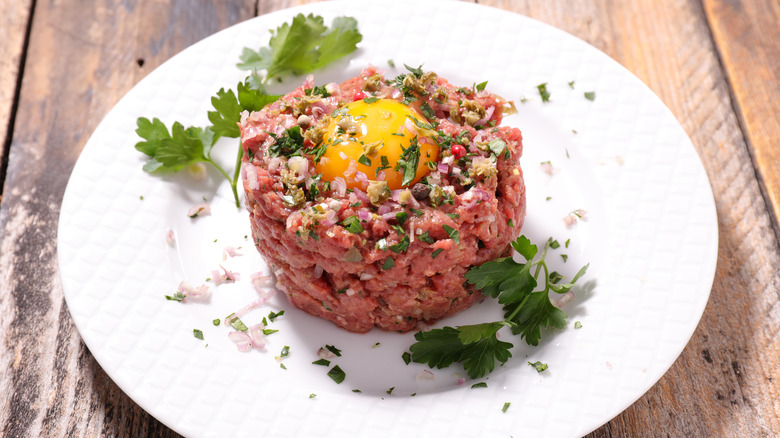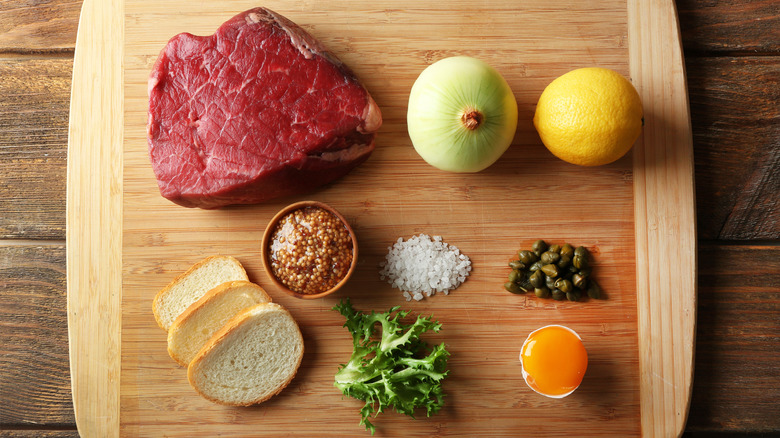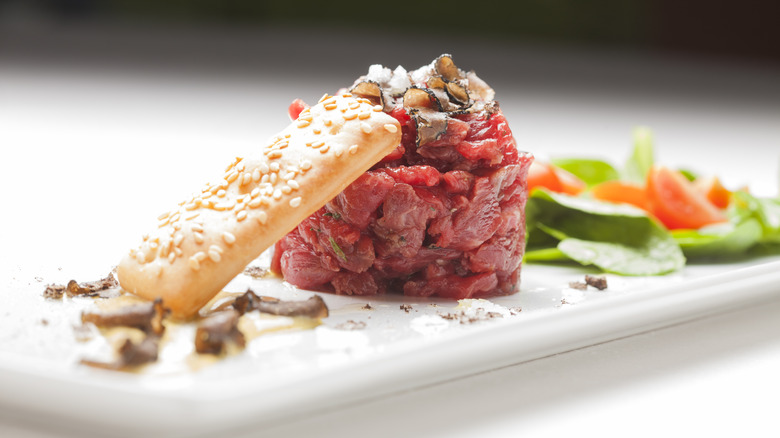How Steak Tartare Is Prepped Differently In France And Italy
It's rare to pick up a menu at any French bistro and not see steak tartare gracing the appetizer section. It's about as standard as steak frites and escargot. While our mind may lean more toward carpaccio when we think of raw beef and Italy, their take on the French staple is simpler, yet with some flavorful distinctions.
A handful of theories exist as to the origin of the steak tartare, but one of the most popular says it was named after a dish known as steak à l'Américaine, an American-influenced dish served in Paris around 1900 that was accompanied by a side of tartar sauce. Other theories suggest the name stems from the Tartar tribes that include the Mongols and Turks and their most famous member, Genghis Khan. Regardless of its inception, other countries have adopted the dish and given it their own twist over the years.
What both preparations do have in common is finely minced beef. When it comes to which meat to use in steak tartare, the less fat, the better, but ultimately the quality of the beef matters more than the cut — it is consumed raw, after all. However, French steak tartare and its Italian counterpart are not one and the same. There are a few slight variations in the dish you'll notice depending on if you're enjoying your steak tartare at a quaint French bistro or an Italian trattoria.
How French steak tartare is made
Classic French steak tartare consists of finely minced beef, authentically done by hand. It is usually made with filet mignon or top-round steak, both lean yet flavorful cuts of meat. Often made tableside at restaurants, the chef will whisk together an egg yolk, Dijon mustard, Worcestershire sauce, and lemon juice in a bowl. Finely diced shallots, capers, parsley, and cornichons are then incorporated along with salt and pepper. The minced beef is tossed in and coated with the mixture and then plated.
Classic plating involves shaping the beef mixture into small rounds with a ramekin or mold and placing a raw egg yolk on top. The dish is always served cool and the bowl and plates are often placed in the freezer to chill before serving. It is typically served with toasted bread. Some variations of French tartare include chives, hot sauce, and even ketchup.
How Italian steak tartare is made
In the Piedmont region of northern Italy, the preparation of steak tartare (known as carne cruda all'abese) is simpler but by no means lacking in flavor. The Italians bolster the dish with two powerful punches of umami — shaved Parmigiano-Reggiano and/or white truffles. The area is known for its white truffles, and a shaving of the prized delicacy is often the final touch on the dish.
Italian tartare's dressing is barebones compared to France's. They merely drizzle the minced raw meat with extra-virgin olive oil, fresh lemon juice, salt and pepper, and often a little garlic. The dressing is mixed into the meat and it is also usually formed into rounds like the French version. Instead of a raw egg yolk garnish, they shave parmesan and/or white truffles, and sometimes hazelnuts or mushrooms atop the mound. In lieu of toast points, it's commonly served atop arugula, watercress, or other delicate greens.


